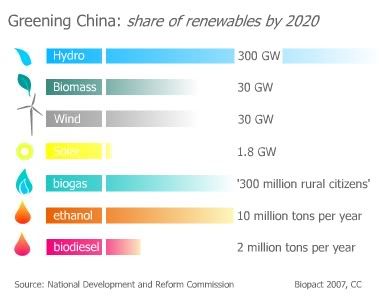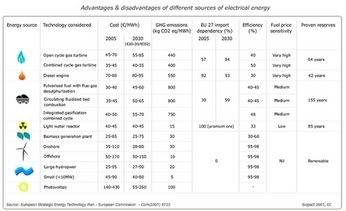Survey on low carbon technologies ranks bioenergy in the middle of the pack
 According to a poll on low carbon technologies conducted by conservationists amongst climate policy makers, bioenergy technologies rank in the middle of the pack. First-generation biofuels are not seen as having a large potential to reduce emissions, while next-generation biofuels, 'biomass from forests' and cogeneration rank much better. The survey did not include third and fourth generation biofuels, nor carbon-negative bioenergy, the most radical technology with which to reduce emissions. The poll also contradicts some basic scientific and economic facts, which is interesting in itself.
According to a poll on low carbon technologies conducted by conservationists amongst climate policy makers, bioenergy technologies rank in the middle of the pack. First-generation biofuels are not seen as having a large potential to reduce emissions, while next-generation biofuels, 'biomass from forests' and cogeneration rank much better. The survey did not include third and fourth generation biofuels, nor carbon-negative bioenergy, the most radical technology with which to reduce emissions. The poll also contradicts some basic scientific and economic facts, which is interesting in itself.The results indicate that the bioenergy community must tackle two problems simultaneously: first there is a clear lack of understanding of the basics of the bioenergy sector, and thus an obvious need to educate policy makers and environmentalists; secondly, it must try to convince campaigners wary of bioenergy of the many potential benefits of the sector. Scientists from the community are not used to lobbying, but it is becoming ever more clear that they too must begin to engage in such an effort.
The poll of 1000 climate decision makers and 'influencers' (environmental lobbyists) was presented by the World Conservation Union, an NGO, in Bali, where policy makers are discussing a post-Kyoto framework aimed at lowering emissions. The results are shown in the graph (click to enlarge).
World upside down
A few observations must be made to explain the quite incomprehensible opinions. The first issue to note is the fact that the polled people rank photovoltaic cells at the top of the list. Objectively speaking, this technology (1) results in more emissions (100 gCO2/kWh) than either wind or bioenergy (both 30 gCO2/kWh), and (2) is by far the most expensive of all possible technologies, up to 10 times as costly as bioenergy, the least expensive per ton of carbon dioxide avoided and per kWh of electricity generated (table, click to enlarge).
The question thus is: why would anyone assume that in a world in which economic feasibility and not idealism is one of the key drivers of achieving a low carbon economy, the most expensive technology represents the best way forward? This survey result is incomprehensible, but we assume questions were put in an idealistic manner and did not delve into how feasible, scaleable and cost-effective the low carbon technologies are. Realism is not one of the hallmarks of the conservationist and environmentalist discourse.
Secondly, the poll does not include the most radical of all technologies capable of reducing emissions, namely carbon-negative bioenergy. This is not difficult to understand: the concept of negative emissions energy has not yet penetrated the policy world and environmentalists are wary of it, because it represents the coupling of high technology being developed in the fossil fuel industry (namely carbon capture and storage - CCS) to bioenergy and biohydrogen production.
Objectively speaking, only bioenergy can result in the production of negative emissions energy. Clean coal which draws on CCS can never become 'carbon negative', because the feedstock is not carbon-neutral. Likewise, all other energy technologies can only remain 'carbon-neutral' at best: they do not add new emissions to the atmosphere, but they do not take carbon dioxide out of it either. Bio-energy with carbon storage (BECS) on the contrary is carbon-negative: it takes historic carbon dioxide out of the atmosphere and can take us back to pre-industrial levels by 2050 (according to the Abrupt Climate Change Strategy group, which has a mandate to study the technology). A biomass power plant coupled to CCS can yield up to minus 1000 gCO2/kWh (that is: -1000gCO2). All other energy technologies have a positive carbon balance ranging from +10 to +100gCO2eq).
In short, the poll is grossly incomplete, because it doesn't include the most powerful technology available to reduce emissions. This of course says a lot about the quality of the survey.
Thirdly, the survey did not take into account the social and economic benefits of the technologies in question. There is a large body of research comparing the employment opportunities generated by different energy technologies. Again, bioenergy ranks at the top of the list, solar photovoltaic at the bottom. Bioenergy also offers a massive opportunity for sustainable development in the developing world, more than any other technology. This is tied to the economics of the energy technologies: bioenergy offers a way to boost economic growth (because countries and rural communities can trade on and export to a global market), whereas all other technologies come at a heavy economic cost. We think economic growth offers a better strategy to conserve the environment than energy insecurity and rural poverty, which are key drivers of environmental degradation. Once more, we can only deduce that these slightly more complex perspectives were not taken into account in the survey.
Finally, the poll results contradict what is actually happening on the ground, the actions of real policy makers and of investors in renewables:
 energy :: sustainability :: biomass :: bioenergy :: biofuels :: renewables :: economics :: climate change :: energy security ::
energy :: sustainability :: biomass :: bioenergy :: biofuels :: renewables :: economics :: climate change :: energy security :: Since 2005, bioenergy has been - by far - the fastest growing renewables sector. The economics are clearly in favor of their promotion, because they are versatile (biomass can be turned in both gaseous, liquid and solid biofuels, and in electricity), can immediately replace fossil fuels in existing infrastructures and thus have an immediate impact on reducing emissions. No other technology achieves this. Moreover, bioenergy does not have the many drawbacks associated with wind or solar power, most notably their lack of the capacity to provide baseload power. In fact, in Germany, the leader in wind power, the sector has even fueled a growth in coal consumption because of this lack of baseload.

There can be only one conclusion from the survey: the bioenergy community must urgently start a campaign to educate policy makers about the sector. The lack of knowledge is simply staggering. Additionally, the community should attempt to bring anti-biofuels advocates back to reason. Like Achim Steiner, head of the UN's Environment Program (UNEP) recently said: these campaigners use 'sledgehammer' tactics and have dumbed down a complex debate by pushing 'extremely simplistic' views on a complex matter. This must be avoided in the future.
Maybe the bioenergy community could begin by conducting a survey amongst environmentalists and conservationists about their knowledge of negative emissions energy systems. The lack of understanding of this key prospect for bioenergy is a first area on which the bioenergy community could focus its educational efforts.
References:
IUCN: Put biodiversity at centre of climate debate, says new experts survey - December 10, 2007.
 --------------
--------------
 The Royal Society of Chemistry has announced it will launch a new journal in summer 2008, Energy & Environmental Science, which will distinctly address both energy and environmental issues. In recognition of the importance of research in this subject, and the need for knowledge transfer between scientists throughout the world, from launch the RSC will make issues of Energy & Environmental Science available free of charge to readers via its
The Royal Society of Chemistry has announced it will launch a new journal in summer 2008, Energy & Environmental Science, which will distinctly address both energy and environmental issues. In recognition of the importance of research in this subject, and the need for knowledge transfer between scientists throughout the world, from launch the RSC will make issues of Energy & Environmental Science available free of charge to readers via its 








0 Comments:
Post a Comment
Links to this post:
Create a Link
<< Home